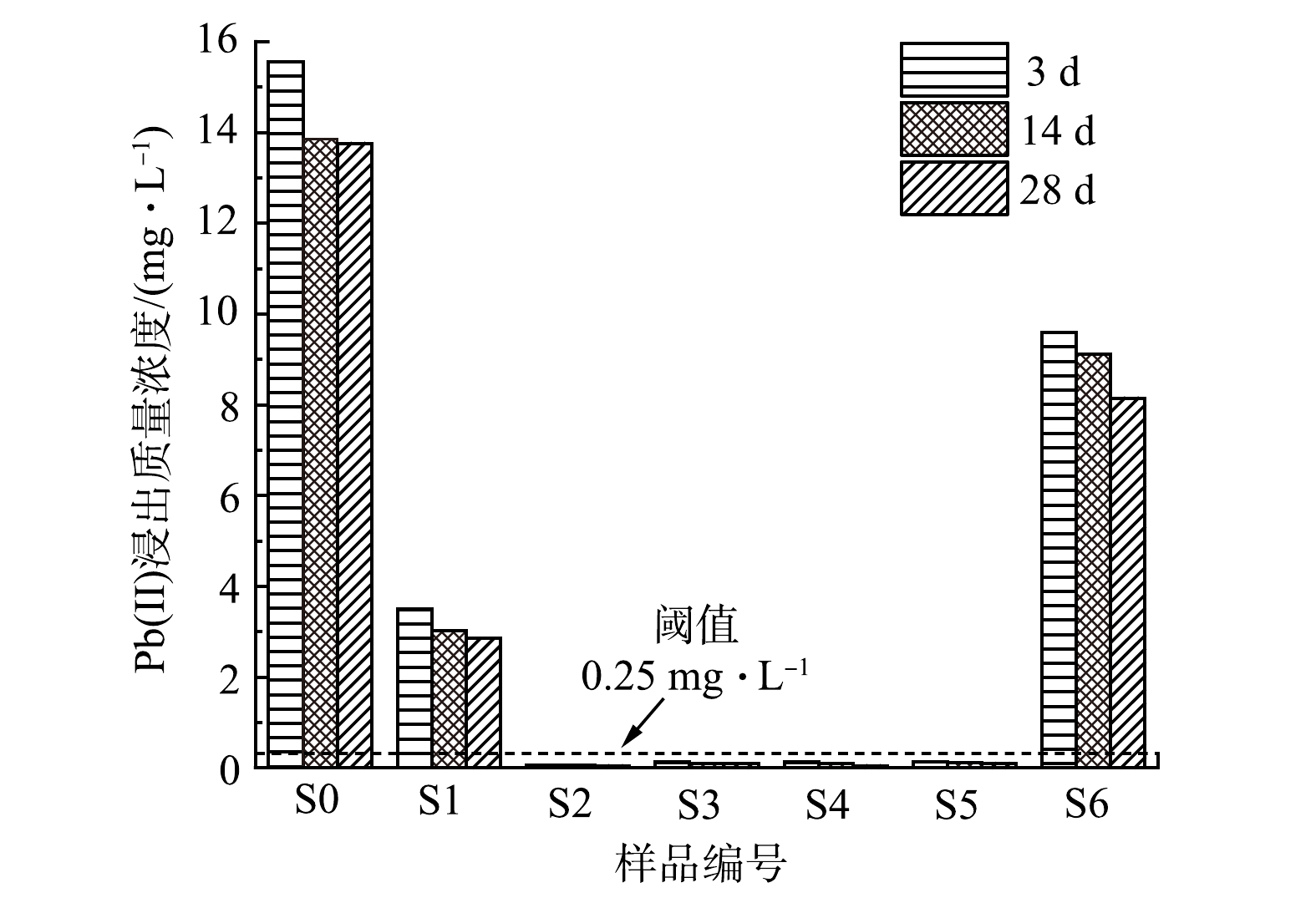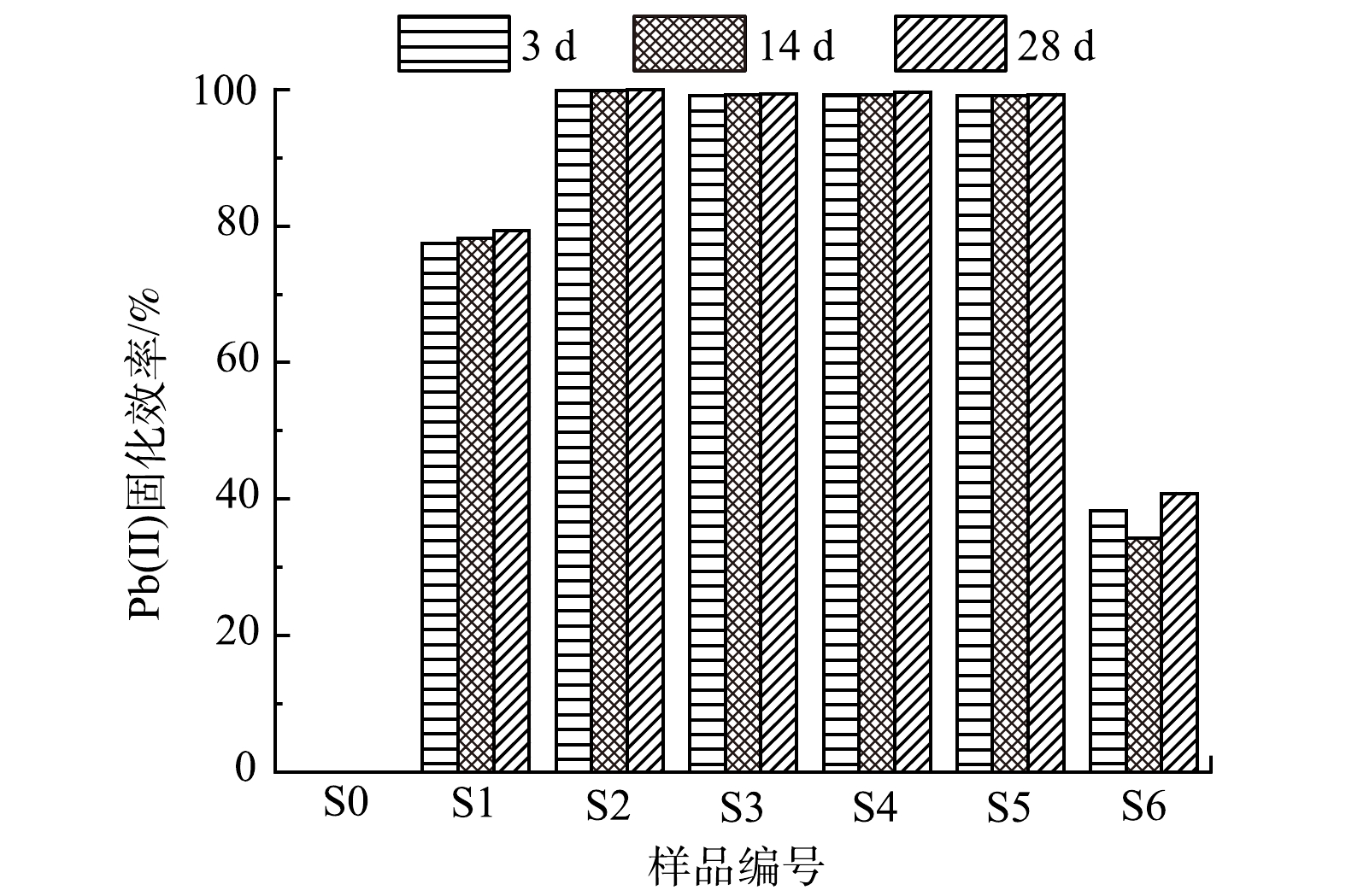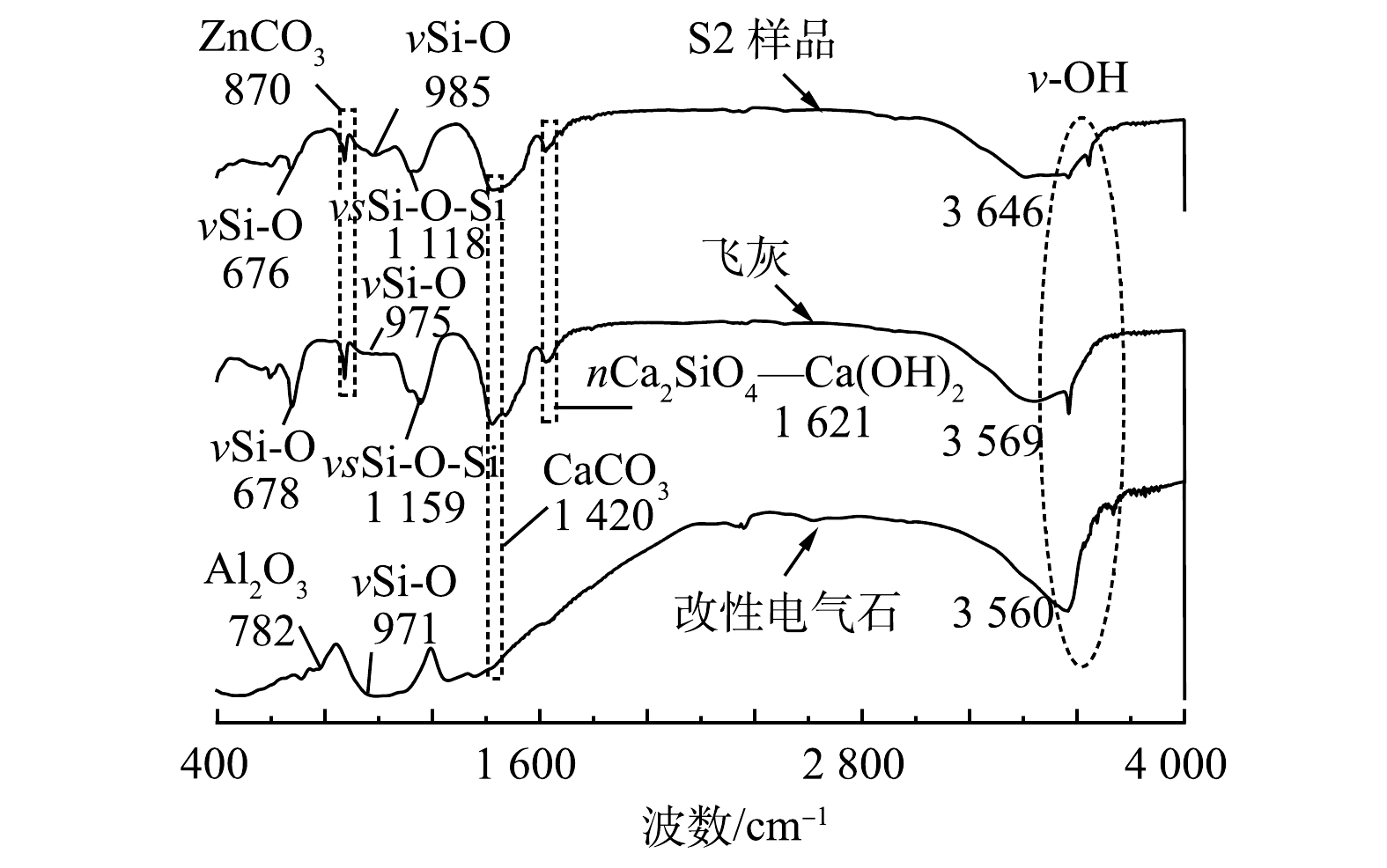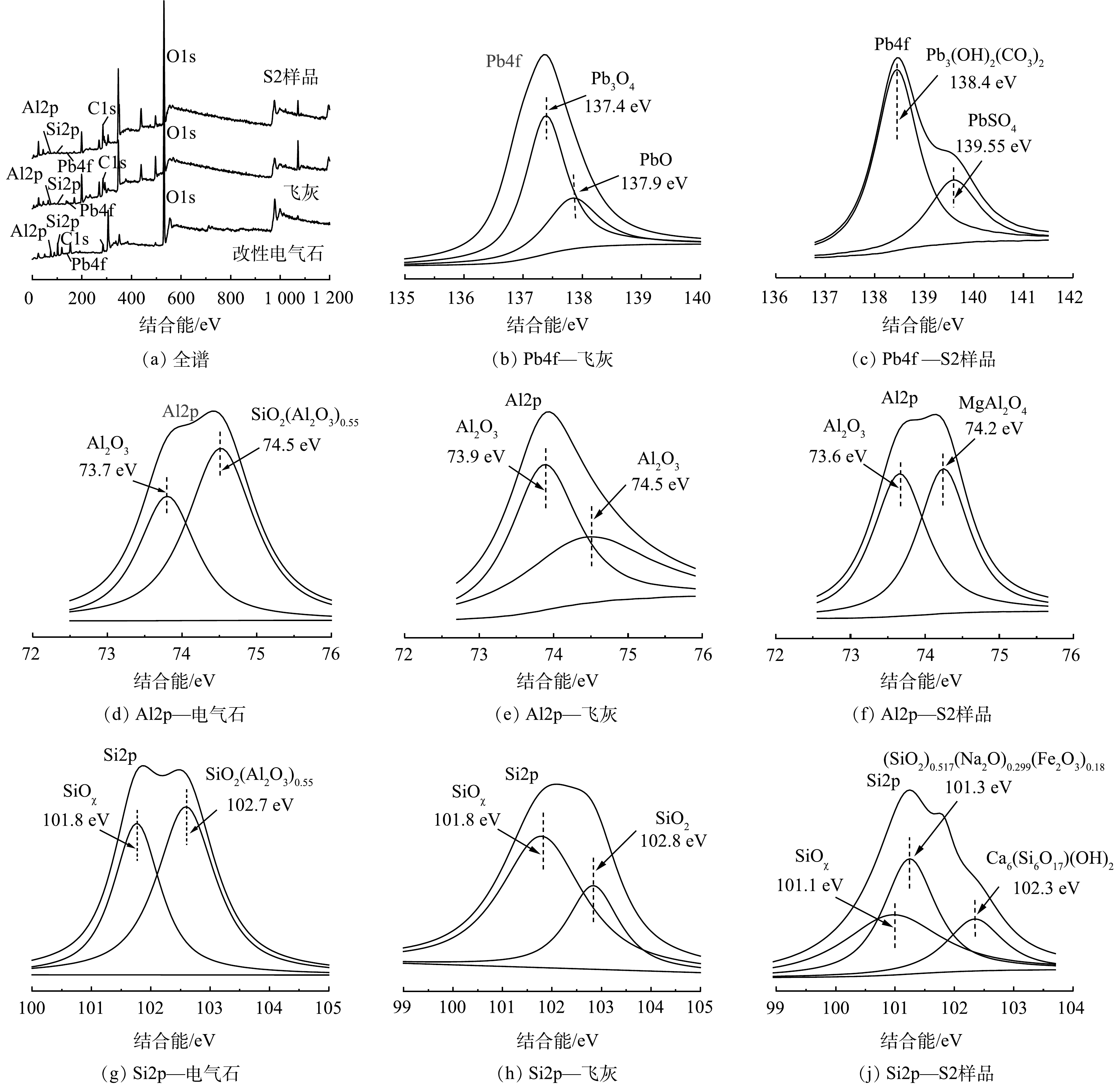-
2020年底公布的《全国大、中城市固体废物污染环境防治年报》[1]显示,近年来生活垃圾产生量有增无减,2019年产生量已经增长至2.4×108 t。焚烧作为我国覆盖面较广的一种生活垃圾处置方式[2],通过减容、减重等途径[3]可以有效解决占地问题。但是,焚烧发电在反应进行及完成阶段都伴有飞灰产生,产生量为垃圾燃烧总量4%左右[4],由于其通常含有浓缩重金属成分以及二恶英等有害物质而被归类为危险废物[5]。当飞灰与酸性、中性液体介质接触时,重金属可高度浸出[6],特别是重金属Pb(Ⅱ)进入人体后,会对人体器官及功能造成严重损害[7]。所以,为了减小对填埋场及周围环境的影响,必须对飞灰进行无害化处理[8]。
对于焚烧飞灰,国内外广泛采取固化/稳定化的方法进行处理[9]。较为常见的处理技术主要包括:药剂稳定化[10]、热处理固化[11]、地聚物固化[12]、碱激发材料固化[13]以及水泥固化[14]等。其中,王震等[15]的研究表明,药剂稳定化技术投资费用低且固化效果好,但由于飞灰中重金属存在形态不稳定,难以找到适用于实际工程的稳定化药剂,且固化后的长期稳定性较差,容易造成二次污染。朱芬芬等[16]发现,热处理固化技术对飞灰中的重金属处理效率很高,但温度升高容易导致有害物质的挥发,且对设备要求较高。ZHAN等[17]通过地聚化合物对飞灰进行固化后发现,飞灰中重金属的浸出率明显降低,同时可以实现以废治废,但地聚物组成性质波动性较大,前期预处理工序复杂,难以投入实际应用。LI等[18]采用赤泥等碱激发原材料制备固化剂,发现可以有效地减少重金属浸出,所形成的固化体的抗腐蚀性能较好,但碱激发材料价格昂贵且固化机理仍待进一步阐释。水泥固化由于具有原料易得、操作简单、二次污染小以及经济效益好等[19]优势,已逐渐成为应用最为广泛的固化处理技术,但由于不溶性重金属盐等物质的存在,会抑制水化反应的进行,当飞灰掺量较高时,水泥固化技术仍存在重金属浸出率高等缺点[20]。另外,据MANGIALARDI等[21]的研究表明,不掺入添加剂对飞灰进行水泥固化处理时,在符合抗压强度和重金属浸出质量浓度控制标准的前提下,水泥用量需达到总物料质量分数的40%左右,大大增加了填埋容量,单一使用水泥进行固化处理容易导致资源的直接消耗和环境的间接污染[22]。电气石作为一种天然的硅酸盐矿物,价格低廉易获取,具有复杂的物质组成和结构,且通常具有一定的表面活性和吸附性能,对重金属有良好的固定和降解作用,但材料自身固结性不强[23],可联合水泥应用于飞灰中重金属的固化稳定化处理。
本研究针对水泥固化飞灰技术中重金属浸出率高、水泥用量大的问题,以电气石为添加剂,经物理球磨改性后联合水泥对飞灰中的重金属Pb(Ⅱ)进行固化,在满足《生活垃圾填埋场污染控制标准》(GB 16889-2008)[24]中抗压强度和浸出质量浓度阈值的基础上大幅度减小水泥用量,以减小填埋容量,提高经济效益性。通过不同固化体的抗压强度及重金属Pb(Ⅱ)浸出质量浓度测定实验,探讨改性电气石添加量、养护时间等因素对抗压强度和重金属Pb(Ⅱ)固化效率的影响。
-
1)原料粒径及组分测定。采用激光粒度仪(S3500型,美国Microtrac公司)测定焚烧飞灰和改性电气石的粒径分布;通过XRF(ARL Perform-X型,美国ThermoFisher Scientific公司)对焚烧飞灰和改性电气石的化学组成进行分析。
2)固化体的制备及养护。结合原料各组分性质,为了保证固化效果的同时大幅度减少水泥用量,进一步减少填埋容量,本实验中水泥和电气石的设计掺量均控制在10%以下(具体配比见表1)。实验流程如图1所示,向混合均匀的飞灰和水泥内加入改性电气石,添加相同比例去离子水,于三相双速异步搅拌机(YDT712-4/8型,浙江德东电机股份有限公司)内搅拌20~40 min,注入4×4×4 cm的三联模具中,经胶砂试体成型振实台(ZT-96型,无锡健鼎电子科技有限公司)振实,于室温下放置24 h后脱模,将固化体移至水泥混凝土恒温恒湿标准养护箱(HBY-40A型,无锡建仪仪器机械有限公司)内分别养护3、14、28 d。
3)抗压强度测定实验。将固化体依据《混凝土物理力学性能试验方法标准》(GB/T 50081-2019)[25]测定抗压强度,本实验由精度等级为1级的万能材料试验机(WE-300S型,绍兴市肯特机械电子有限公司)进行测定,试件抗压强度计算如式(1)所示。
式中:P为抗压强度,MPa;F⊥为垂直破坏荷载,N;A为加载面积,mm2。
4)浸出质量浓度测定实验。将固化体依据《固体废物 浸出毒性浸出方法 醋酸缓冲溶液法》(HJ/T 300-2007)[26]提取浸出液,并将固化体浸出液依据《危险废物鉴别标准 浸出毒性鉴别》(GB 5085.3-2007)[27]进行重金属Pb(Ⅱ)浸出质量浓度测定。
5)材料表征实验。采用FT-IR(Nicolet 5700型,美国ThermoFisher Scientific公司)分析样品表面特征官能团;通过XPS(ESCALAB 250XI型,美国ThermoFisher Scientific公司)对样品主要物质组成及结构形式进行表征。
-
1)焚烧飞灰。本实验中所用焚烧飞灰为炉排炉工艺飞灰,取自武汉星火垃圾焚烧发电厂。飞灰粒径分布为:粒径<4.6 μm的颗粒占7.71%~10.45%;粒径为4.6~18.5 μm的颗粒占48.32% ~ 58.05%;粒径>18.5 μm的颗粒占31.50%~34.24%。粒径分布主要集中于1~20 μm。
飞灰主要化学组成如表2所示。可见,飞灰中Ca、Si、Al及其他金属元素质量分数较大,属于Al2O3-CaO-SiO2体系[28],同时,氯元素在飞灰中占比较大,通常以轻金属元素的氯化物形式存在[29]。飞灰中重金属质量分数及浸出质量浓度如表3所示。可见,以Zn、Pb元素为主的质量分数较高,分别达9 580、2 080 mg·kg−1。通过测定不同重金属浸出质量浓度可知,本研究飞灰中重金属Pb超标严重,其他重金属均低于《生活垃圾填埋场污染控制标准》(GB 16889-2008)[24]中质量浓度限值,因此,本实验针对Pb的固化稳定化做主要研究,以达到填埋标准。
2)改性电气石。本实验所用电气石取自石家庄灵寿县芹丽矿产品加工厂。通过变频行星式球磨机(XQM-4L型,长沙天创粉末技术有限公司)在500 r·m−1条件下进行物理球磨改性,改性后电气石粒径分布为:粒径<3.3 μm的颗粒占10.47%~19.34%;粒径为3.3~18.5 μm的颗粒占49.84%~62.25%;粒径>18.5 μm的颗粒占27.28%~30.82%。粒径主要分布在1~10 μm。改性电气石的化学成分主要由Si (40.75%)、Al (27.51%)、Fe (12.05%) 、Mg (10.24%)等元素组成,且通常以氧化物的形式存在[30]。
3)硅酸盐水泥。本实验中所用硅酸盐水泥为P·O 42.5级商品水泥。常用硅酸盐水泥的化学成分主要含有3CaO·SiO2(50%~70%)、2CaO·SiO2(5%~30%)及铝酸钙、铁铝酸钙等物质[31]。
-
对不同配比固化体养护至不同龄期后进行抗压强度测定,结果如图2所示。由于固化体填埋时需要具有一定抗压强度来保证其不轻易受到外力破坏而导致有害物质浸出,且要保持填埋砌块体形状,因此,危险废物固化体抗压强度须保证在0.98 MPa以上[32]。
由图2可知,本实验中飞灰原样S0固化体以及S3固化体的抗压强度低于限值,当改性电气石添加量为0(S1)、4.3%(S2)、8.3%(S4)、8.7%(S5)和9.1%(S6)时,固化体的抗压强度均满足限值。随着改性电气石添加量的增加,固化体样品抗压强度数据变化存在一定波动,且出现2个强度效果较高且较稳定的峰值3.12和2.43 MPa,分别对应改性电气石添加量为4.3%和8.7%,水泥用量为8.7%和4.3%的S2和S5固化体。另外,虽然个别固化体样品的抗压强度由于养护龄期的不同而存在一定波动,但对整体而言,养护时间从3 d至28 d,固化体样品的抗压强度仍呈现上升趋势。
-
对不同配比固化体养护至不同龄期后进行了重金属Pb(Ⅱ)浸出质量浓度测定,结果如图3所示。为更直观地体现固化效果,通过固化前后重金属Pb(Ⅱ)浸出质量浓度变化计算固化效率,结果如图4所示。根据《生活垃圾填埋场污染控制标准》(GB 16889-2008)[24]要求,按照醋酸缓冲溶液法测定的飞灰固化体浸出液中重金属Pb(Ⅱ)浸出质量浓度必须低于限值(0.25 mg·L−1)才可进行安全填埋。
由图3可看出,本实验中飞灰原样S0固化体中重金属Pb(Ⅱ)浸出质量浓度远高于填埋场的限值,当改性电气石添加量为4.3%(S2)、4.8%(S3)、8.3%(S4)和8.7%(S5)时固化体的重金属Pb(Ⅱ)浸出质量浓度均满足限值。由图4可看出,改性电气石添加比例在4.3%至8.7%范围内重金属Pb(Ⅱ)的固化效率均达99%以上,且在此范围内随着改性电气石添加量的增加,重金属Pb(Ⅱ)的固化效率总体呈现略微下降趋势,效果最佳的改性电气石添加量为4.3%,水泥用量为8.7%的S2固化体,重金属Pb(Ⅱ)的固化效率高达99.97%。另外,对于同一配比的固化体,在不同养护龄期时重金属Pb(Ⅱ)的固化效率差异不明显,可见固化体对重金属Pb(Ⅱ)的固化稳定作用基本在3 d内完成,后面的固化效率基本持平。
因此,固化体抗压强度和重金属Pb(Ⅱ)浸出质量浓度结果表明,处理效果达标的S2、S4和S5固化体,对应改性电气石添加量分别为4.3%、8.3%和8.7%,对应的水泥用量分别仅为8.7%、8.3%和4.3%,其中S2固化体处理效果最好,抗压强度为3.12 MPa,重金属Pb(Ⅱ)的固化效率高达99.97%。另外,相比单一使用水泥来固化处理飞灰中的重金属时水泥用量需为总物料质量之比的40%左右,在满足抗压强度和重金属Pb(Ⅱ)浸出质量浓度标准的前提下,改性电气石的添加至少可以减少总物料比中30%的水泥用量。
-
本研究结合样品原料中各组分的化学组成,通过研究固化前后样品表面特征官能团及主要元素Al、Si、Pb等存在形式的变化,分析固化反应的过程及机理。
1) FT-IR表征结果。通过FT-IR对焚烧飞灰、改性电气石及处理效果最好的S2固化体(28 d)样品表面的特征官能团进行表征,结果如图5所示。可见,整个反应体系中存在游离羟基,且固化后的S2样品中羟基的衍射峰蓝移,结合水分子更多,体系中参与水化反应的物质更多,发生了更多的水化反应。另外,固化后的Si-O键的衍射峰也出现蓝移,波数变大,键能变强,因此,固化体中的SiOχ更加活跃。这说明改性电气石与水泥和飞灰混合后同时有利于激发SiOχ活性。
结合改性电气石基本理化性质及化学组成分析,电气石从矿物学角度而言属于硅酸盐类物质且通常为环状结构[33],其反应活性与颗粒粒径有关[34]。本实验中经过物理球磨改性后电气石粒径变小,比表面积变大且表面无定型化,从而反应活性增强,有利于激发反应体系中羟基和SiOχ活性以及水化反应的进行,对重金属Pb(Ⅱ)的沉淀和包裹保护有一定的促进作用。
2) XPS表征结果。通过XPS对焚烧飞灰、改性电气石及处理效果最好的S2固化体(28 d)样品中主要元素Pb、Al、Si等存在形式进行研究,结果如图6所示。固化前焚烧飞灰中Pb元素主要以Pb3O4和PbO等形式存在,固化后生成新的矿物晶相,主要以Pb3(OH)2(CO3)2形式存在,并含有少量PbSO4。另外,在焚烧飞灰和改性电气石中,Al、Si元素主要以Al2O3、SiOχ和硅铝酸盐(SiO2(Al2O3)0.55)等形式存在,固化后有偏铝酸镁(MgAl2O4)、硬硅钙石(Ca6(Si6O17)(OH)2)及硅酸钠铁盐类物质等新矿物晶相生成。
结合反应体系中水泥的化学组分进行分析,硬硅钙石(Ca6(Si6O17)(OH)2)是水化反应中经生成水化硅酸钙(C–S–H)等[35]中间产物后形成。由于飞灰、改性电气石的掺入,改变了反应体系中的化学组分,反应还生成偏铝酸镁(MgAl2O4)、硅酸钠铁盐类物质等结晶化合物,因而有利于重金属Pb(Ⅱ)的固化,且生成的新矿物晶相具有较大硬度,密实了固化体结构并改善固化体的抗压强度。
结合改性电气石的基本理化性质和表征结果分析,改性电气石表面存在的游离羟基是促进重金属Pb(Ⅱ)沉淀生成Pb3(OH)2(CO3)2的因素之一。且ONORI等[36]的研究表明,含Fe、Al的组分对重金属Pb(Ⅱ)存在一定的表面络合作用,改性电气石中含有SiO2、Al2O3、Fe2O3以及硅铝酸盐(SiO2(Al2O3)0.55)等物质组分有利于重金属Pb(Ⅱ)的固化。本实验中,在满足相应指标的基础上,添加电气石可以减少水泥用量,而且改性电气石的掺入对改善固化体抗压强度和提高重金属Pb(Ⅱ)固化效率有良好效果。
-
1)改性电气石联合水泥处理飞灰中重金属Pb(Ⅱ)时,改性电气石、水泥、飞灰3者之间的最佳质量之比为1∶2∶20。在最佳条件下,固化后抗压强度为3.12 MPa,Pb(Ⅱ)固化效率高达99.97%,可满足生活垃圾填埋场污染控制标准。
2)最佳配比条件下,水泥用量仅为8.7%,改性电气石掺量仅为4.3%,相比纯水泥固化可减少30%的水泥用量,解决了重金属浸出率高、水泥用量大问题;同时,大大减少填埋容量,提高经济效益性,可用于固化飞灰中重金属Pb(Ⅱ)的应用。
3)改性电气石有利于激发SiOχ活性及水化反应,促进Pb(Ⅱ)的沉淀和包裹保护;固化后含铅的稳定态物质比例上升,并主要以Pb3(OH)2(CO3)2形式存在;同时,反应生成Ca6(Si6O17)(OH)2等结晶化合物有利于抗压强度改善和重金属Pb(Ⅱ)固化。
改性电气石联合水泥高效固结飞灰中的Pb(Ⅱ)
Efficient consolidation of Pb(Ⅱ) in fly ash by modified tourmaline combined with cement
-
摘要: 针对水泥固化飞灰技术中重金属浸出率高、水泥用量大的问题,采用添加改性电气石的方法,以实现在满足安全填埋标准基础上大幅度减小水泥用量的目的。通过室内模拟实验,研究了电气石添加量、养护时间等因素对固化体抗压强度和重金属Pb(II)浸出质量浓度的影响;通过FT-IR、XPS等方法对样品特征官能团及形态变化进行表征,研究了Pb(Ⅱ)的固化机理。实验结果表明,当改性电气石、水泥、飞灰3者的质量之比为1∶2∶20时,重金属Pb(II)固化效率高达99.97%,抗压强度为3.12 Mpa,固化效果受电气石添加量影响较大,相比纯水泥固化减少了30%的水泥用量。表征结果显示,掺入改性电气石有利于激发SiOχ活性及水化反应进行,促进了重金属Pb(II)的沉淀和包裹保护,固化后主要以Pb3(OH)2(CO3)2形式存在。本研究结果可为解决水泥固化重金属Pb(II)技术中浸出率高、水泥用量大问题提供参考。Abstract: Aiming at the problems of high heavy metal leaching rate and large cement consumption in cement-solidified fly ash technology, the modified tourmaline was added to reduce cement consumption greatly on the basis of meeting the safety landfill standard. The influences of tourmaline addition, curing time on the compressive strength and leaching concentration of Pb(Ⅱ) were studied by indoor simulation experiment, the solidified mechanism of Pb(Ⅱ) was studied by FT-IR and XPS. The experimental results showed that when the mass ratio of the modified tourmaline: cement: fly ash was 1∶2∶20, the solidified efficiency of Pb(Ⅱ) was as high as 99.97% and compressive strength was 3.12 Mpa. The effect was greatly affected by the amount of tourmaline, and the cement consumption was 30% less than that of pure cement solidified. The characterization results showed that the addition of tourmaline promoted the activation of SiOχ and the hydration reaction, and enhanced the precipitation and encapsulation protection of Pb(Ⅱ), which mainly existed in the form of Pb3(OH)2(CO3)2 after solidified. The results can provide references for solving the problems of high leaching concentration and large cement consumption in cement solidified heavy metal Pb(Ⅱ) technology.
-
Key words:
- fly ash /
- heavy metals /
- tourmaline /
- solidification /
- stabilization treatment
-
2020年底公布的《全国大、中城市固体废物污染环境防治年报》[1]显示,近年来生活垃圾产生量有增无减,2019年产生量已经增长至2.4×108 t。焚烧作为我国覆盖面较广的一种生活垃圾处置方式[2],通过减容、减重等途径[3]可以有效解决占地问题。但是,焚烧发电在反应进行及完成阶段都伴有飞灰产生,产生量为垃圾燃烧总量4%左右[4],由于其通常含有浓缩重金属成分以及二恶英等有害物质而被归类为危险废物[5]。当飞灰与酸性、中性液体介质接触时,重金属可高度浸出[6],特别是重金属Pb(Ⅱ)进入人体后,会对人体器官及功能造成严重损害[7]。所以,为了减小对填埋场及周围环境的影响,必须对飞灰进行无害化处理[8]。
对于焚烧飞灰,国内外广泛采取固化/稳定化的方法进行处理[9]。较为常见的处理技术主要包括:药剂稳定化[10]、热处理固化[11]、地聚物固化[12]、碱激发材料固化[13]以及水泥固化[14]等。其中,王震等[15]的研究表明,药剂稳定化技术投资费用低且固化效果好,但由于飞灰中重金属存在形态不稳定,难以找到适用于实际工程的稳定化药剂,且固化后的长期稳定性较差,容易造成二次污染。朱芬芬等[16]发现,热处理固化技术对飞灰中的重金属处理效率很高,但温度升高容易导致有害物质的挥发,且对设备要求较高。ZHAN等[17]通过地聚化合物对飞灰进行固化后发现,飞灰中重金属的浸出率明显降低,同时可以实现以废治废,但地聚物组成性质波动性较大,前期预处理工序复杂,难以投入实际应用。LI等[18]采用赤泥等碱激发原材料制备固化剂,发现可以有效地减少重金属浸出,所形成的固化体的抗腐蚀性能较好,但碱激发材料价格昂贵且固化机理仍待进一步阐释。水泥固化由于具有原料易得、操作简单、二次污染小以及经济效益好等[19]优势,已逐渐成为应用最为广泛的固化处理技术,但由于不溶性重金属盐等物质的存在,会抑制水化反应的进行,当飞灰掺量较高时,水泥固化技术仍存在重金属浸出率高等缺点[20]。另外,据MANGIALARDI等[21]的研究表明,不掺入添加剂对飞灰进行水泥固化处理时,在符合抗压强度和重金属浸出质量浓度控制标准的前提下,水泥用量需达到总物料质量分数的40%左右,大大增加了填埋容量,单一使用水泥进行固化处理容易导致资源的直接消耗和环境的间接污染[22]。电气石作为一种天然的硅酸盐矿物,价格低廉易获取,具有复杂的物质组成和结构,且通常具有一定的表面活性和吸附性能,对重金属有良好的固定和降解作用,但材料自身固结性不强[23],可联合水泥应用于飞灰中重金属的固化稳定化处理。
本研究针对水泥固化飞灰技术中重金属浸出率高、水泥用量大的问题,以电气石为添加剂,经物理球磨改性后联合水泥对飞灰中的重金属Pb(Ⅱ)进行固化,在满足《生活垃圾填埋场污染控制标准》(GB 16889-2008)[24]中抗压强度和浸出质量浓度阈值的基础上大幅度减小水泥用量,以减小填埋容量,提高经济效益性。通过不同固化体的抗压强度及重金属Pb(Ⅱ)浸出质量浓度测定实验,探讨改性电气石添加量、养护时间等因素对抗压强度和重金属Pb(Ⅱ)固化效率的影响。
1. 材料与方法
1.1 实验方法
1)原料粒径及组分测定。采用激光粒度仪(S3500型,美国Microtrac公司)测定焚烧飞灰和改性电气石的粒径分布;通过XRF(ARL Perform-X型,美国ThermoFisher Scientific公司)对焚烧飞灰和改性电气石的化学组成进行分析。
2)固化体的制备及养护。结合原料各组分性质,为了保证固化效果的同时大幅度减少水泥用量,进一步减少填埋容量,本实验中水泥和电气石的设计掺量均控制在10%以下(具体配比见表1)。实验流程如图1所示,向混合均匀的飞灰和水泥内加入改性电气石,添加相同比例去离子水,于三相双速异步搅拌机(YDT712-4/8型,浙江德东电机股份有限公司)内搅拌20~40 min,注入4×4×4 cm的三联模具中,经胶砂试体成型振实台(ZT-96型,无锡健鼎电子科技有限公司)振实,于室温下放置24 h后脱模,将固化体移至水泥混凝土恒温恒湿标准养护箱(HBY-40A型,无锡建仪仪器机械有限公司)内分别养护3、14、28 d。
表 1 不同原料配比方案Table 1. Experimental protocols for different raw material ratios样品编号 原料掺量/g 改性电气石 硅酸盐水泥 飞灰 S0 0 0 300 S1 0 30 300 S2 15 30 300 S3 16 16 300 S4 30 30 300 S5 30 15 300 S6 30 0 300 3)抗压强度测定实验。将固化体依据《混凝土物理力学性能试验方法标准》(GB/T 50081-2019)[25]测定抗压强度,本实验由精度等级为1级的万能材料试验机(WE-300S型,绍兴市肯特机械电子有限公司)进行测定,试件抗压强度计算如式(1)所示。
P=F⊥A (1) 式中:P为抗压强度,MPa;F⊥为垂直破坏荷载,N;A为加载面积,mm2。
4)浸出质量浓度测定实验。将固化体依据《固体废物 浸出毒性浸出方法 醋酸缓冲溶液法》(HJ/T 300-2007)[26]提取浸出液,并将固化体浸出液依据《危险废物鉴别标准 浸出毒性鉴别》(GB 5085.3-2007)[27]进行重金属Pb(Ⅱ)浸出质量浓度测定。
5)材料表征实验。采用FT-IR(Nicolet 5700型,美国ThermoFisher Scientific公司)分析样品表面特征官能团;通过XPS(ESCALAB 250XI型,美国ThermoFisher Scientific公司)对样品主要物质组成及结构形式进行表征。
1.2 实验材料
1)焚烧飞灰。本实验中所用焚烧飞灰为炉排炉工艺飞灰,取自武汉星火垃圾焚烧发电厂。飞灰粒径分布为:粒径<4.6 μm的颗粒占7.71%~10.45%;粒径为4.6~18.5 μm的颗粒占48.32% ~ 58.05%;粒径>18.5 μm的颗粒占31.50%~34.24%。粒径分布主要集中于1~20 μm。
飞灰主要化学组成如表2所示。可见,飞灰中Ca、Si、Al及其他金属元素质量分数较大,属于Al2O3-CaO-SiO2体系[28],同时,氯元素在飞灰中占比较大,通常以轻金属元素的氯化物形式存在[29]。飞灰中重金属质量分数及浸出质量浓度如表3所示。可见,以Zn、Pb元素为主的质量分数较高,分别达9 580、2 080 mg·kg−1。通过测定不同重金属浸出质量浓度可知,本研究飞灰中重金属Pb超标严重,其他重金属均低于《生活垃圾填埋场污染控制标准》(GB 16889-2008)[24]中质量浓度限值,因此,本实验针对Pb的固化稳定化做主要研究,以达到填埋标准。
表 2 飞灰的主要成分Table 2. Main compositions of fly ash %Cl Ca K Si Mg Fe Al 37.46 34.91 11.54 1.23 0.663 0.559 0.318 表 3 飞灰的重金属质量分数及浸出质量浓度Table 3. Heavy metal mass content and leaching mass concentration of fly ash重金属元素 质量分数/% 浸出质量浓度/(mg·L−1) 填埋标准/(mg·L−1) Zn 0.958 16.18 < 100 Pb 0.208 15.56 < 0.25 Cu 0.087 2.900 < 40 Cd 0.035 0.081 < 0.15 Cr 0.015 0.246 < 1.5 Ni 0.003 0.037 < 0.5 2)改性电气石。本实验所用电气石取自石家庄灵寿县芹丽矿产品加工厂。通过变频行星式球磨机(XQM-4L型,长沙天创粉末技术有限公司)在500 r·m−1条件下进行物理球磨改性,改性后电气石粒径分布为:粒径<3.3 μm的颗粒占10.47%~19.34%;粒径为3.3~18.5 μm的颗粒占49.84%~62.25%;粒径>18.5 μm的颗粒占27.28%~30.82%。粒径主要分布在1~10 μm。改性电气石的化学成分主要由Si (40.75%)、Al (27.51%)、Fe (12.05%) 、Mg (10.24%)等元素组成,且通常以氧化物的形式存在[30]。
3)硅酸盐水泥。本实验中所用硅酸盐水泥为P·O 42.5级商品水泥。常用硅酸盐水泥的化学成分主要含有3CaO·SiO2(50%~70%)、2CaO·SiO2(5%~30%)及铝酸钙、铁铝酸钙等物质[31]。
2. 结果与讨论
2.1 固化体的抗压强度
对不同配比固化体养护至不同龄期后进行抗压强度测定,结果如图2所示。由于固化体填埋时需要具有一定抗压强度来保证其不轻易受到外力破坏而导致有害物质浸出,且要保持填埋砌块体形状,因此,危险废物固化体抗压强度须保证在0.98 MPa以上[32]。
由图2可知,本实验中飞灰原样S0固化体以及S3固化体的抗压强度低于限值,当改性电气石添加量为0(S1)、4.3%(S2)、8.3%(S4)、8.7%(S5)和9.1%(S6)时,固化体的抗压强度均满足限值。随着改性电气石添加量的增加,固化体样品抗压强度数据变化存在一定波动,且出现2个强度效果较高且较稳定的峰值3.12和2.43 MPa,分别对应改性电气石添加量为4.3%和8.7%,水泥用量为8.7%和4.3%的S2和S5固化体。另外,虽然个别固化体样品的抗压强度由于养护龄期的不同而存在一定波动,但对整体而言,养护时间从3 d至28 d,固化体样品的抗压强度仍呈现上升趋势。
2.2 固化体的重金属Pb(Ⅱ)浸出质量浓度
对不同配比固化体养护至不同龄期后进行了重金属Pb(Ⅱ)浸出质量浓度测定,结果如图3所示。为更直观地体现固化效果,通过固化前后重金属Pb(Ⅱ)浸出质量浓度变化计算固化效率,结果如图4所示。根据《生活垃圾填埋场污染控制标准》(GB 16889-2008)[24]要求,按照醋酸缓冲溶液法测定的飞灰固化体浸出液中重金属Pb(Ⅱ)浸出质量浓度必须低于限值(0.25 mg·L−1)才可进行安全填埋。
由图3可看出,本实验中飞灰原样S0固化体中重金属Pb(Ⅱ)浸出质量浓度远高于填埋场的限值,当改性电气石添加量为4.3%(S2)、4.8%(S3)、8.3%(S4)和8.7%(S5)时固化体的重金属Pb(Ⅱ)浸出质量浓度均满足限值。由图4可看出,改性电气石添加比例在4.3%至8.7%范围内重金属Pb(Ⅱ)的固化效率均达99%以上,且在此范围内随着改性电气石添加量的增加,重金属Pb(Ⅱ)的固化效率总体呈现略微下降趋势,效果最佳的改性电气石添加量为4.3%,水泥用量为8.7%的S2固化体,重金属Pb(Ⅱ)的固化效率高达99.97%。另外,对于同一配比的固化体,在不同养护龄期时重金属Pb(Ⅱ)的固化效率差异不明显,可见固化体对重金属Pb(Ⅱ)的固化稳定作用基本在3 d内完成,后面的固化效率基本持平。
因此,固化体抗压强度和重金属Pb(Ⅱ)浸出质量浓度结果表明,处理效果达标的S2、S4和S5固化体,对应改性电气石添加量分别为4.3%、8.3%和8.7%,对应的水泥用量分别仅为8.7%、8.3%和4.3%,其中S2固化体处理效果最好,抗压强度为3.12 MPa,重金属Pb(Ⅱ)的固化效率高达99.97%。另外,相比单一使用水泥来固化处理飞灰中的重金属时水泥用量需为总物料质量之比的40%左右,在满足抗压强度和重金属Pb(Ⅱ)浸出质量浓度标准的前提下,改性电气石的添加至少可以减少总物料比中30%的水泥用量。
2.3 样品表面特征变化
本研究结合样品原料中各组分的化学组成,通过研究固化前后样品表面特征官能团及主要元素Al、Si、Pb等存在形式的变化,分析固化反应的过程及机理。
1) FT-IR表征结果。通过FT-IR对焚烧飞灰、改性电气石及处理效果最好的S2固化体(28 d)样品表面的特征官能团进行表征,结果如图5所示。可见,整个反应体系中存在游离羟基,且固化后的S2样品中羟基的衍射峰蓝移,结合水分子更多,体系中参与水化反应的物质更多,发生了更多的水化反应。另外,固化后的Si-O键的衍射峰也出现蓝移,波数变大,键能变强,因此,固化体中的SiOχ更加活跃。这说明改性电气石与水泥和飞灰混合后同时有利于激发SiOχ活性。
结合改性电气石基本理化性质及化学组成分析,电气石从矿物学角度而言属于硅酸盐类物质且通常为环状结构[33],其反应活性与颗粒粒径有关[34]。本实验中经过物理球磨改性后电气石粒径变小,比表面积变大且表面无定型化,从而反应活性增强,有利于激发反应体系中羟基和SiOχ活性以及水化反应的进行,对重金属Pb(Ⅱ)的沉淀和包裹保护有一定的促进作用。
2) XPS表征结果。通过XPS对焚烧飞灰、改性电气石及处理效果最好的S2固化体(28 d)样品中主要元素Pb、Al、Si等存在形式进行研究,结果如图6所示。固化前焚烧飞灰中Pb元素主要以Pb3O4和PbO等形式存在,固化后生成新的矿物晶相,主要以Pb3(OH)2(CO3)2形式存在,并含有少量PbSO4。另外,在焚烧飞灰和改性电气石中,Al、Si元素主要以Al2O3、SiOχ和硅铝酸盐(SiO2(Al2O3)0.55)等形式存在,固化后有偏铝酸镁(MgAl2O4)、硬硅钙石(Ca6(Si6O17)(OH)2)及硅酸钠铁盐类物质等新矿物晶相生成。
结合反应体系中水泥的化学组分进行分析,硬硅钙石(Ca6(Si6O17)(OH)2)是水化反应中经生成水化硅酸钙(C–S–H)等[35]中间产物后形成。由于飞灰、改性电气石的掺入,改变了反应体系中的化学组分,反应还生成偏铝酸镁(MgAl2O4)、硅酸钠铁盐类物质等结晶化合物,因而有利于重金属Pb(Ⅱ)的固化,且生成的新矿物晶相具有较大硬度,密实了固化体结构并改善固化体的抗压强度。
结合改性电气石的基本理化性质和表征结果分析,改性电气石表面存在的游离羟基是促进重金属Pb(Ⅱ)沉淀生成Pb3(OH)2(CO3)2的因素之一。且ONORI等[36]的研究表明,含Fe、Al的组分对重金属Pb(Ⅱ)存在一定的表面络合作用,改性电气石中含有SiO2、Al2O3、Fe2O3以及硅铝酸盐(SiO2(Al2O3)0.55)等物质组分有利于重金属Pb(Ⅱ)的固化。本实验中,在满足相应指标的基础上,添加电气石可以减少水泥用量,而且改性电气石的掺入对改善固化体抗压强度和提高重金属Pb(Ⅱ)固化效率有良好效果。
3. 结论
1)改性电气石联合水泥处理飞灰中重金属Pb(Ⅱ)时,改性电气石、水泥、飞灰3者之间的最佳质量之比为1∶2∶20。在最佳条件下,固化后抗压强度为3.12 MPa,Pb(Ⅱ)固化效率高达99.97%,可满足生活垃圾填埋场污染控制标准。
2)最佳配比条件下,水泥用量仅为8.7%,改性电气石掺量仅为4.3%,相比纯水泥固化可减少30%的水泥用量,解决了重金属浸出率高、水泥用量大问题;同时,大大减少填埋容量,提高经济效益性,可用于固化飞灰中重金属Pb(Ⅱ)的应用。
3)改性电气石有利于激发SiOχ活性及水化反应,促进Pb(Ⅱ)的沉淀和包裹保护;固化后含铅的稳定态物质比例上升,并主要以Pb3(OH)2(CO3)2形式存在;同时,反应生成Ca6(Si6O17)(OH)2等结晶化合物有利于抗压强度改善和重金属Pb(Ⅱ)固化。
-
表 1 不同原料配比方案
Table 1. Experimental protocols for different raw material ratios
样品编号 原料掺量/g 改性电气石 硅酸盐水泥 飞灰 S0 0 0 300 S1 0 30 300 S2 15 30 300 S3 16 16 300 S4 30 30 300 S5 30 15 300 S6 30 0 300 表 2 飞灰的主要成分
Table 2. Main compositions of fly ash %
Cl Ca K Si Mg Fe Al 37.46 34.91 11.54 1.23 0.663 0.559 0.318 表 3 飞灰的重金属质量分数及浸出质量浓度
Table 3. Heavy metal mass content and leaching mass concentration of fly ash
重金属元素 质量分数/% 浸出质量浓度/(mg·L−1) 填埋标准/(mg·L−1) Zn 0.958 16.18 < 100 Pb 0.208 15.56 < 0.25 Cu 0.087 2.900 < 40 Cd 0.035 0.081 < 0.15 Cr 0.015 0.246 < 1.5 Ni 0.003 0.037 < 0.5 -
[1] 中华人民共和国国家统计局. 中国统计年鉴2020[M]. 北京: 中国统计出版社, 2020. [2] 刘敬勇, 孙水裕. 城市污泥焚烧过程中重金属形态与分布的热力学平衡分析[J]. 中国有色金属学报, 2010, 20(8): 1645-1655. [3] CUCCHIELLA F, D’ADAMO I, GASTALDI M. Sustainable waste management: Waste to energy plant as an alternative to landfill[J]. Energy Conversion and Management, 2017, 131: 18-31. doi: 10.1016/j.enconman.2016.11.012 [4] 杨光, 包兵, 丁文川, 等. 有机螯合剂与磷酸盐联合稳定垃圾焚烧飞灰中重金属的作用机理[J]. 环境工程学报, 2019, 13(8): 1967-1976. doi: 10.12030/j.cjee.201811158 [5] TANG J, STEENARI B M. Leaching optimization of municipal solid waste incineration ash for resource recovery: A case study of Cu, Zn, Pb and Cd[J]. Waste Management, 2015, 48(3): 315-322. [6] 蓝际荣, 孙燕, 潘滢, 等. 球磨与助剂强化选择性回收电解锰渣中的锰[J]. 中国有色金属学报, 2019, 29(8): 1749-1755. [7] 郑鹏, 刘建国, 刘锋, 等. 垃圾焚烧飞灰磷酸洗涤对重金属的固定效应研究[J]. 环境工程学报, 2007, 1(1): 121-125. doi: 10.3969/j.issn.1673-9108.2007.01.031 [8] 汪莉, 柴立元, 闵小波, 等. 重金属废渣的硫固定稳定化[J]. 中国有色金属学报, 2008, 18(11): 2105-2110. doi: 10.3321/j.issn:1004-0609.2008.11.026 [9] ZACCO A, BORGESE L, GIANONCELLI A, et al. Review of fly ash inertisation treatments and recycling[J]. Environmental Chemistry Letters, 2014, 12(1): 153-175. doi: 10.1007/s10311-014-0454-6 [10] 李建陶, 曾鸣, 杜兵, 等. 垃圾焚烧飞灰药剂稳定化矿物学特性[J]. 中国环境科学, 2017, 37(11): 4188-4194. doi: 10.3969/j.issn.1000-6923.2017.11.023 [11] 刘富强, 秘田静, 钟瑞琳. 烧结条件对垃圾焚烧飞灰中重金属固定率的影响[J]. 环境科学与技术, 2013, 36(5): 47-50. doi: 10.3969/j.issn.1003-6504.2013.05.010 [12] ZHANG M, EL-KORCHI T, ZHANG G P, et al. Synthesis factors affecting mechanical properties, microstructure, and chemical composition of red mud-fly ash based geopolymers[J]. Fuel, 2014, 134: 315-325. doi: 10.1016/j.fuel.2014.05.058 [13] WANG Y G, HAN F L, MU J Q. Solidification/stabilization mechanism of Pb(II), Cd(II), Mn(II) and Cr(III) in fly ash based geopolymers[J]. Construction and Building Materials, 2018, 160: 818-827. doi: 10.1016/j.conbuildmat.2017.12.006 [14] WANG X X, LI A M, ZHANG Z K. The effects of water washing on cement-based stabilization of MWSI fly ash[J]. Procedia Environmental Sciences, 2016, 31: 440-446. doi: 10.1016/j.proenv.2016.02.095 [15] 王震. 重金属污染物的化学稳定化研究[D]. 广州: 中国科学院大学(中国科学院广州地球化学研究所), 2019 [16] 朱芬芬, 柳晓燕, 韩媚玲, 等. 烧结升温方式及气氛对水洗焚烧飞灰晶体演变的影响[J]. 中国环境科学, 2019, 39(10): 4212-4220. doi: 10.3969/j.issn.1000-6923.2019.10.022 [17] ZHAN X, WANG L, HU C, et al. Co-disposal of MSWI fly ash and electrolytic manganese residue based on geopolymeric system[J]. Waste Management, 2018, 82: 62-70. doi: 10.1016/j.wasman.2018.10.014 [18] LI Y C, MIN X B, KE Y, et al. Preparation of red mud-based geopolymer materials from MSWI fly ash and red mud by mechanical activation[J]. Waste Management, 2019, 83: 202-208. doi: 10.1016/j.wasman.2018.11.019 [19] 孙杨雨, 焦春磊, 谭笑, 等. 生活垃圾焚烧飞灰中重金属的稳定化及其机理研究[J]. 中国科学:化学, 2016, 46(7): 716-724. [20] BIE R S, CHEN P, SONG X F, et al. Characteristics of municipal solid waste incineration fly ash with cement solidification treatment[J]. Journal of the Energy Institute, 2016, 89(4): 704-712. doi: 10.1016/j.joei.2015.04.006 [21] MANGIALARDI T, PAOLINI A E, POLETTINI A, et al. Optimization of the solidification/stabilization process of MSW fly ash in cementitious matrices[J]. Journal of Hazardous Materials, 1999, 70(1/2): 53-70. [22] 唐强, 陈辉, 尹立新, 等. 生活垃圾焚烧飞灰固化体力学及重金属浸出特性[J]. 环境工程学报, 2017, 35(4): 111-114,159. [23] WANG B M, FAN C C. Hydration behavior and immobilization mechanism of MgO-SiO2-H2O cementitious system blended with MSWI fly ash[J]. Chemosphere, 2020, 250: 126269. doi: 10.1016/j.chemosphere.2020.126269 [24] 中华人民共和国生态环境部, 中华人民共和国国家质量监督检验检疫总局. 生活垃圾填埋场污染控制标准: GB 16889-2008[S]. 北京: 中国环境科学出版社, 2008. [25] 中华人民共和国住房和城乡建设部, 中华人民共和国国家市场监督管理总局. 混凝土物理力学性能试验方法标准: GB/T 50081-2019[S]. 北京: 中国建筑工业出版社, 2019. [26] 中华人民共和国国家环境保护总局. 固体废物 浸出毒性浸出方法 醋酸缓冲溶液法: HJ/T 300-2007[S]. 北京: 中国环境科学出版社, 2007. [27] 中华人民共和国国家环境保护总局, 中华人民共和国国家质量监督检验检疫总局. 危险废物鉴别标准 浸出毒性鉴别: GB 5085.3-2007[S]. 北京: 中国环境科学出版社, 2007. [28] LIU J, HU L, TANG L P, et al. Utilization of municipal solid waste incinerator (MSWI) fly ash with metkaolin for preparation of alkali-activated cementitious material[J]. Journal of Hazardous Materials, 2020, 402(4): 123451. [29] 林森, 孙仕勇, 申珂璇, 等. 电气石的环境功能属性及其复合功能材料应用研究[J]. 材料导报, 2017, 13(17): 1005-023. [30] ERTL A, VERESHCHAGIN O S, GIESTER G, et al. Structural and chemical investigation of a zoned synthetic Cu-rich tourmaline[J]. Canadian Mineralogist, 2015, 53(2): 209-219. doi: 10.3749/canmin.1400078 [31] POULSEN S L, KOCABA V, LESAOUT G, et al. Improved quantification of alite and belite in anhydrous Portland cements by Si-29 MAS NMR: Effects of paramagnetic ions[J]. Solid State Nuclear Magnetic Resonance, 2009, 36(1): 32-44. doi: 10.1016/j.ssnmr.2009.05.001 [32] 中华人民共和国住房和城乡建设部. 生活垃圾焚烧处理工程技术规范: CJJ 90-2002[S]. 北京: 中国建筑工业出版社, 2002. [33] LONDON D. Formation of tourmaline-rich gem pockets in miarolitic pegmatites[J]. American Mineralogist, 1986, 71(3/4): 396-405. [34] 张洪臣. 电气石的高温热行为研究[D]. 天津: 河北工业大学, 2015. [35] 郝玉, 徐宏勇, 柏舸, 等. 垃圾焚烧飞灰中Cd、Pb、Zn的螯合稳定与水泥固化处理[J]. 环境工程学报, 2018, 12(8): 2357-2362. doi: 10.12030/j.cjee.201803036 [36] ONORI R, POLETTNI A, POMI A. Mechanical properties and leaching modeling of activated incinerator bottom ash in Portland cement blends[J]. Waste Management, 2011, 31(2): 298-310. doi: 10.1016/j.wasman.2010.05.021 -






 DownLoad:
DownLoad:







